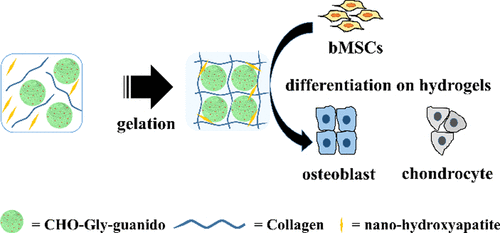当前位置:
X-MOL 学术
›
ACS Sustain. Chem. Eng.
›
论文详情
Our official English website, www.x-mol.net, welcomes your
feedback! (Note: you will need to create a separate account there.)
Glycogen as a Cross-Linking Agent of Collagen and Nanohydroxyapatite To Form Hydrogels for bMSC Differentiation
ACS Sustainable Chemistry & Engineering ( IF 7.1 ) Pub Date : 2020-01-16 , DOI: 10.1021/acssuschemeng.9b07051 Xihe Zhang 1 , Juan Zhou 1 , Huiyan Ying 1 , Yuting Zhou 1 , Jiahui Lai 1 , Jinghua Chen 1
ACS Sustainable Chemistry & Engineering ( IF 7.1 ) Pub Date : 2020-01-16 , DOI: 10.1021/acssuschemeng.9b07051 Xihe Zhang 1 , Juan Zhou 1 , Huiyan Ying 1 , Yuting Zhou 1 , Jiahui Lai 1 , Jinghua Chen 1
Affiliation

|
Polysaccharides have been considered as an important linker of organics and minerals in the scaffold for bone repair. In this study, we exploited glycogen as the contactor of collagen and hydroxyapatite to form composite hydrogels since it could provide stereoscopic multiple sites for reaction with other components. Glycogen was modified with guanido followed by oxidization to aldehyde, which subsequently combined with collagen and hydroxyapatite through a Schiff base bond and electrostatic interaction, respectively. The resulting hydrogels could almost maintain their prototypes within 2 weeks, with little degradation. Their Young’s modulus (10–70 kPa) and compressive modulus (30–432 kPa) were all within the range of properties required for stem cells to differentiate into osteoblasts or cartilage. Additionally, bone mesenchymal stem cells cultured on the composite hydrogels presented desirable cell adhesion, viability, and growth. The ratio of collagen/glycogen/hydroxyapatite (HAP) components could regulate bone mesenchymal stem cell differentiation into osteoblasts or chondrocytes, which was confirmed by alkaline phosphatase (ALP) activity and related gene expression assays. The results demonstrated that glycogen could be a promising coupling agent for bone scaffold and the collagen/glycogen/nano-HAP (C/G/H) composite hydrogels would be a potential scaffold for bone tissue engineering.
中文翻译:

糖原作为胶原蛋白和纳米羟基磷灰石的交联剂以形成用于bMSC分化的水凝胶
多糖已被认为是支架中用于骨骼修复的有机物和矿物质的重要连接体。在这项研究中,我们利用糖原作为胶原蛋白和羟基磷灰石的接触剂来形成复合水凝胶,因为它可以提供立体的多个位点来与其他成分反应。糖原用胍基修饰,然后氧化为醛,随后通过席夫碱键和静电相互作用分别与胶原蛋白和羟基磷灰石结合。所得的水凝胶几乎可以在2周内保持其原型,几乎没有降解。它们的杨氏模量(10–70 kPa)和压缩模量(30–432 kPa)都在干细胞分化为成骨细胞或软骨所需的性能范围内。此外,在复合水凝胶上培养的骨间充质干细胞具有理想的细胞粘附性,生存能力和生长能力。胶原/糖原/羟磷灰石(HAP)组分的比例可调节骨间充质干细胞向成骨细胞或软骨细胞的分化,这已通过碱性磷酸酶(ALP)活性和相关基因表达分析得以证实。结果表明,糖原可能是一种有希望的骨支架偶联剂,而胶原蛋白/糖原/纳米-HAP(C / G / H)复合水凝胶将是骨组织工程的潜在支架。碱性磷酸酶(ALP)活性和相关基因表达分析证实了这一点。结果表明,糖原可能是一种有希望的骨支架偶联剂,而胶原蛋白/糖原/纳米-HAP(C / G / H)复合水凝胶将是骨组织工程的潜在支架。碱性磷酸酶(ALP)活性和相关基因表达分析证实了这一点。结果表明,糖原可能是一种有希望的骨支架偶联剂,而胶原蛋白/糖原/纳米-HAP(C / G / H)复合水凝胶将是骨组织工程的潜在支架。
更新日期:2020-01-17
中文翻译:

糖原作为胶原蛋白和纳米羟基磷灰石的交联剂以形成用于bMSC分化的水凝胶
多糖已被认为是支架中用于骨骼修复的有机物和矿物质的重要连接体。在这项研究中,我们利用糖原作为胶原蛋白和羟基磷灰石的接触剂来形成复合水凝胶,因为它可以提供立体的多个位点来与其他成分反应。糖原用胍基修饰,然后氧化为醛,随后通过席夫碱键和静电相互作用分别与胶原蛋白和羟基磷灰石结合。所得的水凝胶几乎可以在2周内保持其原型,几乎没有降解。它们的杨氏模量(10–70 kPa)和压缩模量(30–432 kPa)都在干细胞分化为成骨细胞或软骨所需的性能范围内。此外,在复合水凝胶上培养的骨间充质干细胞具有理想的细胞粘附性,生存能力和生长能力。胶原/糖原/羟磷灰石(HAP)组分的比例可调节骨间充质干细胞向成骨细胞或软骨细胞的分化,这已通过碱性磷酸酶(ALP)活性和相关基因表达分析得以证实。结果表明,糖原可能是一种有希望的骨支架偶联剂,而胶原蛋白/糖原/纳米-HAP(C / G / H)复合水凝胶将是骨组织工程的潜在支架。碱性磷酸酶(ALP)活性和相关基因表达分析证实了这一点。结果表明,糖原可能是一种有希望的骨支架偶联剂,而胶原蛋白/糖原/纳米-HAP(C / G / H)复合水凝胶将是骨组织工程的潜在支架。碱性磷酸酶(ALP)活性和相关基因表达分析证实了这一点。结果表明,糖原可能是一种有希望的骨支架偶联剂,而胶原蛋白/糖原/纳米-HAP(C / G / H)复合水凝胶将是骨组织工程的潜在支架。











































 京公网安备 11010802027423号
京公网安备 11010802027423号